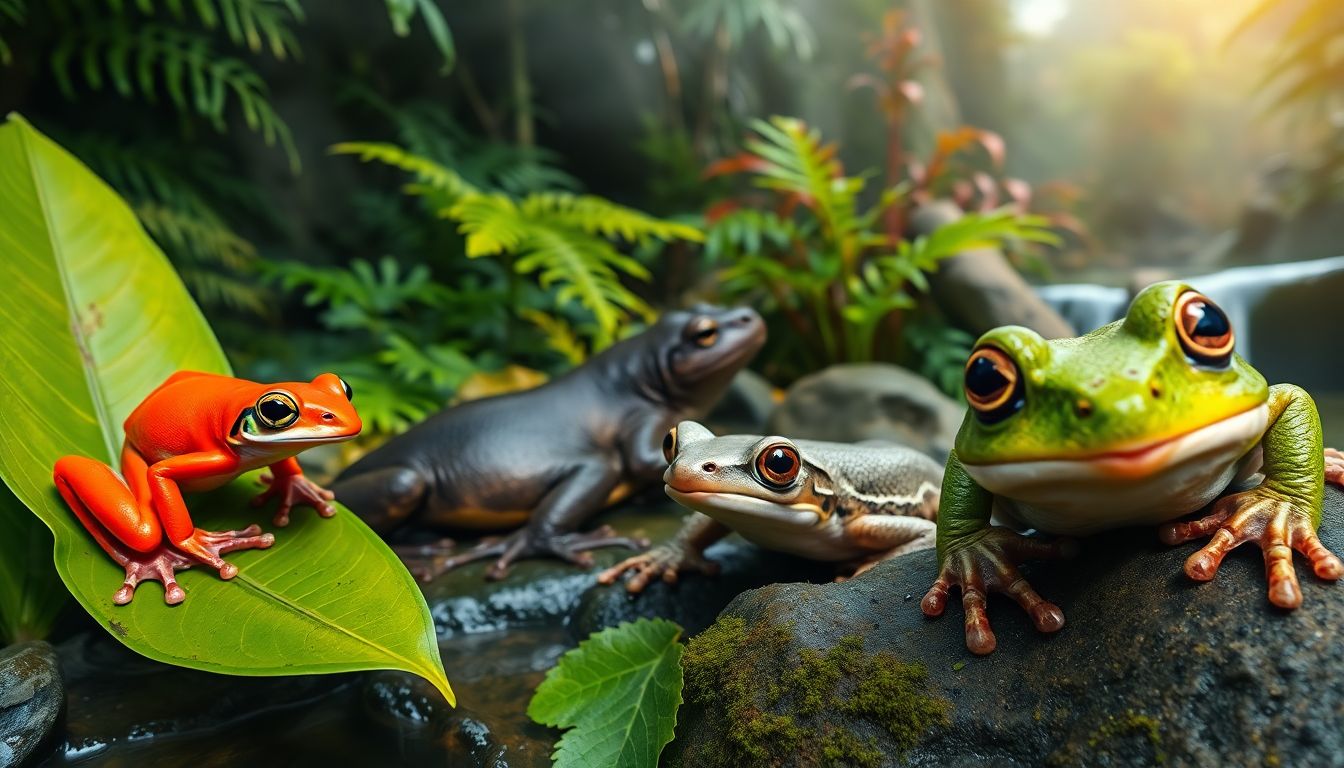
Did you know some frogs can freeze solid in winter and then thaw out to hop away in spring? Amphibians are truly some of nature's most amazing survivors. They are cold-blooded animals that change a lot during their lives. They start in the water and many later live on land.
This article will explore the world of amphibians, talking about all the different kinds. We'll also dive into how they live and why they are so important to our environment.
What Defines an Amphibian?
The word "amphibian" comes from Greek. It means "both lives." This name fits them well because they often live both in water and on land during their lives.
Key Characteristics of Amphibians
Amphibians have a few things that make them special. They are cold-blooded, which means their body temperature changes with the environment around them. They also have skin that lets water and air pass through. This helps them breathe, but it also means they can dry out easily. Most amphibians go through metamorphosis, changing from a young form to an adult form. And they usually have four limbs.
Their skin helps them absorb water, but it also makes them prone to drying. It's a delicate balance for survival.
Amphibian Classification: The Three Orders
There are three main groups of amphibians. First, there are Anura. This group includes frogs and toads. They are known for their jumping legs and lack of tails as adults. Urodela is next. These are salamanders and newts, creatures with tails and longer bodies. Lastly, we have Apoda, or caecilians. These look like snakes or worms and have no limbs.
The Amazing Life Cycle of Amphibians
The amphibian life is a trip. Most of them start as eggs in the water and change a lot as they grow. This process is called metamorphosis.
From Egg to Tadpole: The Aquatic Beginning
Amphibians usually lay their eggs in water. These eggs hatch into larvae, often called tadpoles. Tadpoles live in the water and breathe with gills, like fish. They eat plants and grow before their big change.
Metamorphosis: Transformation on Land and Water
Metamorphosis happens because of hormones in the amphibian's body. Tadpoles grow legs, their tails shrink, and they develop lungs to breathe air. Frogs lose their tail completely, while salamanders keep theirs. Caecilians develop rings around their bodies. Now they are ready for land.
Adulthood: Life on Land (and Water)
Adult amphibians live in different places. Many live near water so they do not dry out. They eat insects and other small creatures. Amphibians reproduce in various ways, from laying eggs in water to giving birth to live young.
Amphibian Habitats and Geographic Distribution
Amphibians live in many different places around the world. You can find them in rainforests, deserts, and even high up in the mountains.
Global Distribution of Amphibian Orders
Frogs are found almost everywhere, from the tropics to colder regions. Salamanders mostly live in North America and Europe. Caecilians are found in the tropics of South America, Africa, and Asia.
Amphibians in Extreme Environments
Some amphibians are really tough. Desert frogs can survive long periods without water by burying themselves in the ground. High-altitude salamanders live in cold mountain streams. These critters are survivors.
The Ecological Role of Amphibians
Amphibians play a big role in keeping ecosystems healthy.
Amphibians as Indicators of Environmental Health
Amphibians are very sensitive to changes in their environment. If there is pollution or habitat loss, they are often the first to disappear. This makes them great bioindicators. Their health tells us a lot about the health of the environment. Pollution, habitat loss, and climate change all hurt amphibians.
Amphibians in the Food Chain
Amphibians eat insects and other invertebrates. They also become food for bigger animals. They help control insect populations and provide food for snakes, birds, and mammals.
Conservation Challenges and Efforts
Sadly, amphibian populations are dropping all over the world.
Threats to Amphibian Survival
The biggest threats to amphibians are habitat loss, climate change, and pollution. A disease called chytrid fungus is also killing many frogs. Invasive species can also outcompete them.
Conservation Strategies and Initiatives
People are trying to save amphibians in various ways. These include protecting their habitats, breeding them in captivity, and studying diseases like chytrid fungus. You can help by supporting conservation groups and reducing pollution.
Conclusion
Amphibians are unique and important creatures. They face many challenges, but we can help them. Learning more about them and supporting conservation can make a big difference. Protect these cold-blooded friends.











0 Comments